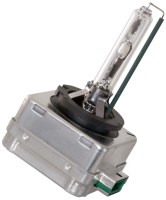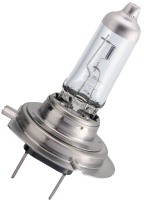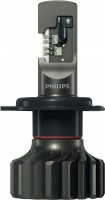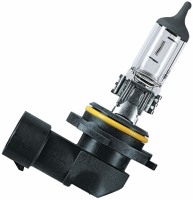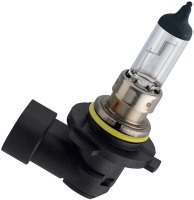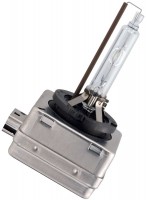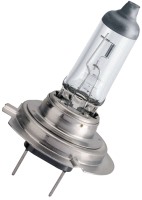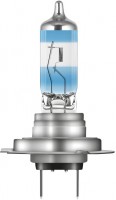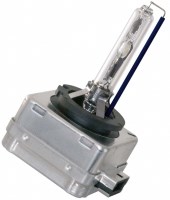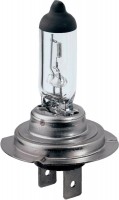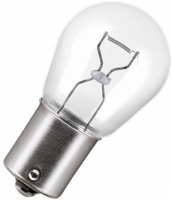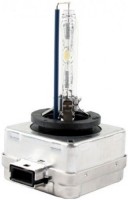Car Bulbs Osram H7
All Car Bulbs Advanced filters → |
You might be interested in
Car Bulbs: specifications, types
Type
The type determines the operating principle of the auto lamp and its design features.
— Incandescent. In this case, we mean traditional incandescent lamps, not related to “halogens” (see below). The bulb of such a lamp is filled with an inert gas or vacuum, and the light is provided by a red-hot filament of refractory metal. The main advantage of such light sources is their simplicity and low cost. At the same time, both in terms of efficiency and performance parameters such as brightness and service life, they are inferior to more advanced varieties, therefore, in general, they are considered obsolete and are used extremely rarely for headlights - the main area of application for incandescent lamps is auxiliary lighting and the instrument panel (see. "Destination")
— Halogen. A specific type of incandescent lamp (see above), differing in the composition of the gas in the bulb - it contains halogen vapor, usually bromine or iodine. This allows for greater brightness, increased efficiency and lifespan, while reducing size and power consumption - all without significantly increasing cost. True, in terms of efficiency, such lamps are still inferior to LED models; on the other hand, halogens provide a more natural glow and are better suited for working over long distances. Thanks to this combination of characteristics, this particular type of lamp is the most popular as a head light (see “...Purpose”); and although xenon lamps are more diverse in the number of models, halogen lamps surpass them in the overall frequency of use.
— Light-emitting diode (LED). LED lamps are notable primarily for their extremely high efficiency, which allows them to achieve high brightness with low power consumption. True, such models are highly expensive, and the color of their glow is “colder” and less natural than that of incandescent lamps. LED lamps are more expensive than halogen lamps, but they are superior in energy efficiency, which helps save fuel. Therefore, in the role of head light (see “Purpose”), this type of lamp is becoming more and more common, gradually replacing halogen lamps. And in auxiliary lighting, “LEDs” are perhaps the most popular variety. We also note that among such lamps there are models that can work with both operating voltages - 12 V and 24 V; See "Voltage" for details.
— Xenon. Classic xenon lamps that have one operating mode (unlike bi-xenon, see below) and are designed for cars where two separate lamps are used for low and high beam. In all xenon auto lamps, the bulb is filled with the inert gas xenon containing pairs of specially selected metals, and the light source is an electric discharge in the environment of this gas. Such models are quite expensive and complex in themselves; in addition, to operate they require a special ignition unit (see below), and it is not always supplied. On the other hand, due to its high brightness and efficiency, xenon is considered the most advanced type of headlight lamps (see “Purpose”); such lamps, among other things, are popular among fans of external tuning. This variety is not used in principle for auxiliary lighting.
— Bi-xenon. Xenon lamps (see above), which have two operating modes and are capable of providing both low and high beam. The exact method for switching between modes may vary. Thus, some models use a movable reflector that changes the characteristics of the light beam; in others, two xenon capsules are installed in one flask; in others, two separate bulbs are used, etc. You should pay attention to this option if both the low and high beam in the headlight are provided by one lamp. Such models are not cheap - more expensive than the xenon/halogen alternative (see below) - but they are used much more often due to their more advanced characteristics.
— Xenon/halogen. Combined lamps having two separate bulbs: xenon for low beam and halogen for high beam. For more information about each of these types, see above; and this option is an alternative to bi-xenon (also see above) for cars where one lamp is responsible for the low and high beam. Xenon-halogen lamps are noticeably cheaper than bi-xenon lamps, and are inferior in efficiency mainly when using high beams. On the other hand, the xenon part usually has a shorter service life than the halogen part, and if it fails, the entire lamp will have to be replaced. In addition, the bulbs may not be located on the same axis, which in some cases causes problems with adjusting the headlights; and the heat generation during operation of both bulbs is quite high and in some cases can even lead to damage to the headlight. As a result, there are significantly fewer combination lamps on the market than bi-xenon lamps.
— Incandescent. In this case, we mean traditional incandescent lamps, not related to “halogens” (see below). The bulb of such a lamp is filled with an inert gas or vacuum, and the light is provided by a red-hot filament of refractory metal. The main advantage of such light sources is their simplicity and low cost. At the same time, both in terms of efficiency and performance parameters such as brightness and service life, they are inferior to more advanced varieties, therefore, in general, they are considered obsolete and are used extremely rarely for headlights - the main area of application for incandescent lamps is auxiliary lighting and the instrument panel (see. "Destination")
— Halogen. A specific type of incandescent lamp (see above), differing in the composition of the gas in the bulb - it contains halogen vapor, usually bromine or iodine. This allows for greater brightness, increased efficiency and lifespan, while reducing size and power consumption - all without significantly increasing cost. True, in terms of efficiency, such lamps are still inferior to LED models; on the other hand, halogens provide a more natural glow and are better suited for working over long distances. Thanks to this combination of characteristics, this particular type of lamp is the most popular as a head light (see “...Purpose”); and although xenon lamps are more diverse in the number of models, halogen lamps surpass them in the overall frequency of use.
— Light-emitting diode (LED). LED lamps are notable primarily for their extremely high efficiency, which allows them to achieve high brightness with low power consumption. True, such models are highly expensive, and the color of their glow is “colder” and less natural than that of incandescent lamps. LED lamps are more expensive than halogen lamps, but they are superior in energy efficiency, which helps save fuel. Therefore, in the role of head light (see “Purpose”), this type of lamp is becoming more and more common, gradually replacing halogen lamps. And in auxiliary lighting, “LEDs” are perhaps the most popular variety. We also note that among such lamps there are models that can work with both operating voltages - 12 V and 24 V; See "Voltage" for details.
— Xenon. Classic xenon lamps that have one operating mode (unlike bi-xenon, see below) and are designed for cars where two separate lamps are used for low and high beam. In all xenon auto lamps, the bulb is filled with the inert gas xenon containing pairs of specially selected metals, and the light source is an electric discharge in the environment of this gas. Such models are quite expensive and complex in themselves; in addition, to operate they require a special ignition unit (see below), and it is not always supplied. On the other hand, due to its high brightness and efficiency, xenon is considered the most advanced type of headlight lamps (see “Purpose”); such lamps, among other things, are popular among fans of external tuning. This variety is not used in principle for auxiliary lighting.
— Bi-xenon. Xenon lamps (see above), which have two operating modes and are capable of providing both low and high beam. The exact method for switching between modes may vary. Thus, some models use a movable reflector that changes the characteristics of the light beam; in others, two xenon capsules are installed in one flask; in others, two separate bulbs are used, etc. You should pay attention to this option if both the low and high beam in the headlight are provided by one lamp. Such models are not cheap - more expensive than the xenon/halogen alternative (see below) - but they are used much more often due to their more advanced characteristics.
— Xenon/halogen. Combined lamps having two separate bulbs: xenon for low beam and halogen for high beam. For more information about each of these types, see above; and this option is an alternative to bi-xenon (also see above) for cars where one lamp is responsible for the low and high beam. Xenon-halogen lamps are noticeably cheaper than bi-xenon lamps, and are inferior in efficiency mainly when using high beams. On the other hand, the xenon part usually has a shorter service life than the halogen part, and if it fails, the entire lamp will have to be replaced. In addition, the bulbs may not be located on the same axis, which in some cases causes problems with adjusting the headlights; and the heat generation during operation of both bulbs is quite high and in some cases can even lead to damage to the headlight. As a result, there are significantly fewer combination lamps on the market than bi-xenon lamps.
Number in set
Number of lamps included in delivery.
The headlight lamps (see “Purpose”) are paired and can be supplied either one or two at a time - the latter is ideal if you need to install or replace both lamps at once. Also, paired configurations can be found in models for auxiliary lighting, and sometimes such lamps are supplied in sets of 10 or even 100 pieces - this can be useful, for example, for installing side lights on a bus or truck. But the dashboard lamps are sold exclusively one at a time.
The headlight lamps (see “Purpose”) are paired and can be supplied either one or two at a time - the latter is ideal if you need to install or replace both lamps at once. Also, paired configurations can be found in models for auxiliary lighting, and sometimes such lamps are supplied in sets of 10 or even 100 pieces - this can be useful, for example, for installing side lights on a bus or truck. But the dashboard lamps are sold exclusively one at a time.
Socket
The type of base used in the lamp.
The base is the contact part of the lamp, which is fixed in the socket and is responsible for fixation, electrical connection and the possibility of safe removal. Thus, the type of base directly determines compatibility with a particular cartridge. However, in addition to this, there is also such a parameter as the base of the base. It determines primarily the contact configuration used on a particular base. And in our paragraph it is written as the second value.
In lamps for different purposes (see above), the set of bases used is very different. So, for the head light the following options are used: D1S, D1R, D2S, D2R, D3S , D3R, D4S, D4R, H1, H2, H3, H4, H7, H8, H9, H10, H11, H13, H15, H16, H27W /1, H27W/2, HB1, HB3, HB4, HB5, HIR2, HS1, M5, R2. For markers and other similar lights, in particular, C5W, C10W, C15W, H21W, H6W, P21W, PY21W, P21/4W, P21/5W, P27/7W, PR21W, R5W, R10W, T4W, W5W, WY5W, W16W are used , W21W, WY21W, W21/5W.
If desired, you can find a detailed explanation of each designation in special sources.
The base is the contact part of the lamp, which is fixed in the socket and is responsible for fixation, electrical connection and the possibility of safe removal. Thus, the type of base directly determines compatibility with a particular cartridge. However, in addition to this, there is also such a parameter as the base of the base. It determines primarily the contact configuration used on a particular base. And in our paragraph it is written as the second value.
In lamps for different purposes (see above), the set of bases used is very different. So, for the head light the following options are used: D1S, D1R, D2S, D2R, D3S , D3R, D4S, D4R, H1, H2, H3, H4, H7, H8, H9, H10, H11, H13, H15, H16, H27W /1, H27W/2, HB1, HB3, HB4, HB5, HIR2, HS1, M5, R2. For markers and other similar lights, in particular, C5W, C10W, C15W, H21W, H6W, P21W, PY21W, P21/4W, P21/5W, P27/7W, PR21W, R5W, R10W, T4W, W5W, WY5W, W16W are used , W21W, WY21W, W21/5W.
If desired, you can find a detailed explanation of each designation in special sources.
Rated power
The power normally consumed by the lamp during operation. This parameter is often used to evaluate the overall brightness of the glow, especially in the case of lamps for headlights (see "Purpose"): such a specific parameter as the luminous flux, firstly, is less familiar to ordinary car owners, and secondly, in its characteristics are not always indicated. However, it must be remembered that only lamps of the same type (see above) can be compared with each other in terms of power consumption. different types can differ markedly in efficiency and luminosity. But what this indicator directly affects is the power consumption of the lamp and, accordingly, the load experienced by the generator or battery. Modern car lamps have a power of up to 100 W, such power consumption is normally tolerated by the on-board network in normal operation. However, the lower horsepower provides some fuel savings.
Voltage
Operating voltage of the auto lamp.
In different types of equipment, the voltage of on-board networks is also different. Therefore, car lamps for passenger cars are designed for a voltage of 12 V, and car lamps for trucks(and other similar equipment, such as buses) are designed for 24 V. However, there are also more specific options:
— 12/24 V. Lamps with the possibility of use in both types of on-board networks - both passenger cars and trucks. This versatility is found mainly among LED models, as well as in some types of xenon (see “Type”): these types of lamps are equipped with control circuits that can automatically adjust to the on-board network voltage.
— 85 V. Value found in models with xenon operating principle (see “Type”). In this case, we mean the voltage supplied to the lamp from the ignition unit (see below); the ignition unit itself is connected to the on-board network and is usually designed for 12 V. Data on the operating voltage of the lamp itself may be needed if you need to select a separate ignition unit for it.
- 40 V. Another option for increased voltage in xenon lamps; the meaning is completely similar to the 85 V described above, but is much less common.
In different types of equipment, the voltage of on-board networks is also different. Therefore, car lamps for passenger cars are designed for a voltage of 12 V, and car lamps for trucks(and other similar equipment, such as buses) are designed for 24 V. However, there are also more specific options:
— 12/24 V. Lamps with the possibility of use in both types of on-board networks - both passenger cars and trucks. This versatility is found mainly among LED models, as well as in some types of xenon (see “Type”): these types of lamps are equipped with control circuits that can automatically adjust to the on-board network voltage.
— 85 V. Value found in models with xenon operating principle (see “Type”). In this case, we mean the voltage supplied to the lamp from the ignition unit (see below); the ignition unit itself is connected to the on-board network and is usually designed for 12 V. Data on the operating voltage of the lamp itself may be needed if you need to select a separate ignition unit for it.
- 40 V. Another option for increased voltage in xenon lamps; the meaning is completely similar to the 85 V described above, but is much less common.
Beam angle (LED)
The angle of illumination provided by the LED car lamp (see “Type”). This parameter, as a rule, is selected by the manufacturer taking into account the purpose (see above) and other features of the lamp’s use.
Models for headlights (see “Purpose”) usually have fairly large coverage angles - from 270° to 360°(the latter cover almost the entire sphere, with the exception of the space behind the base). This is necessary to work effectively with headlight reflectors. Theoretically, the larger the illumination angle, the more efficiently the reflector area is used and the higher the actual brightness; however, in practice this difference is not so noticeable, and much depends on the specific configuration of the reflectors. A specific type of LED headlight lamps are models with an illumination angle of about 60°, in which the concentration of the light beam is ensured by the built-in reflectors of the lamp itself.
In turn, in auxiliary lighting, the angles are selected for the specific specialization of the lamp and are usually at least 120°(maximum - the same 360°).
Models for headlights (see “Purpose”) usually have fairly large coverage angles - from 270° to 360°(the latter cover almost the entire sphere, with the exception of the space behind the base). This is necessary to work effectively with headlight reflectors. Theoretically, the larger the illumination angle, the more efficiently the reflector area is used and the higher the actual brightness; however, in practice this difference is not so noticeable, and much depends on the specific configuration of the reflectors. A specific type of LED headlight lamps are models with an illumination angle of about 60°, in which the concentration of the light beam is ensured by the built-in reflectors of the lamp itself.
In turn, in auxiliary lighting, the angles are selected for the specific specialization of the lamp and are usually at least 120°(maximum - the same 360°).
Brightness
Luminous flux produced by a car lamp; for dual-mode models like bi-xenon (see “Type”), the value at maximum brightness is indicated.
This parameter characterizes the actual brightness and efficiency of the lamp; it can be used to directly evaluate and compare different models, regardless of their type and power consumption (but only at the same color temperature - see below for more details). The brightest are headlight lamps (see “Purpose”), in them this indicator can exceed 4000 lm and vary noticeably from model to model. Therefore, when choosing such a lamp, you should pay special attention to the characteristics of the luminous flux. It should be borne in mind that too bright headlights are just as undesirable as too dim ones: high brightness creates not only the risk of dazzling for oncoming cars, but also discomfort for the driver himself. Optimal luminous flux values can be indicated in the documents for the car or for the headlight itself; if such data is not available, you can turn to other special sources.
As for other types of lamps, in models for auxiliary lighting the luminous flux is up to 800 lm, and in lamps for the instrument panel - up to 55 lm. Moreover, in both cases, the brightness is selected by the manufacturer taking into account the specific specialization and location of the lamp, so in such models this parameter is not a key one.
This parameter characterizes the actual brightness and efficiency of the lamp; it can be used to directly evaluate and compare different models, regardless of their type and power consumption (but only at the same color temperature - see below for more details). The brightest are headlight lamps (see “Purpose”), in them this indicator can exceed 4000 lm and vary noticeably from model to model. Therefore, when choosing such a lamp, you should pay special attention to the characteristics of the luminous flux. It should be borne in mind that too bright headlights are just as undesirable as too dim ones: high brightness creates not only the risk of dazzling for oncoming cars, but also discomfort for the driver himself. Optimal luminous flux values can be indicated in the documents for the car or for the headlight itself; if such data is not available, you can turn to other special sources.
As for other types of lamps, in models for auxiliary lighting the luminous flux is up to 800 lm, and in lamps for the instrument panel - up to 55 lm. Moreover, in both cases, the brightness is selected by the manufacturer taking into account the specific specialization and location of the lamp, so in such models this parameter is not a key one.
Colour temperature
The colour temperature of the light emitted by the lamp. The overall colour of the glow depends on this indicator; and note that the higher the colour temperature, the more “cold” the light looks, the closer it is to blue and blue. Traditional incandescent bulbs produce warm light at 2500-3000K, 3000-3500K can be described as "slightly warmer than neutral", neutral white corresponds to temperatures of 3700-4500K, higher values correspond to cooler shades, and temperatures over 5000K characteristic of lamps with a blue (blue) colour of the glow.
Note that in this case the colour temperature of the lamp itself (more precisely, its filament or LED element) is indicated, and not the actual shade of the glow that it will give out; for the difference between these indicators, see "Glow colour". Also note here that it is possible to evaluate the shade of light by colour temperature in headlight lamps (see "Intended use"), for which the white colour of the glow is claimed. At the same time, this indicator has a very practical meaning: the warm colour of the light is considered optimal in wet weather, the neutral one gives the highest visible brightness, all other things being equal, and the cold “long-range” one can be subjectively pleasant for some drivers, and can also be used as an element of external tuning.
Note that in this case the colour temperature of the lamp itself (more precisely, its filament or LED element) is indicated, and not the actual shade of the glow that it will give out; for the difference between these indicators, see "Glow colour". Also note here that it is possible to evaluate the shade of light by colour temperature in headlight lamps (see "Intended use"), for which the white colour of the glow is claimed. At the same time, this indicator has a very practical meaning: the warm colour of the light is considered optimal in wet weather, the neutral one gives the highest visible brightness, all other things being equal, and the cold “long-range” one can be subjectively pleasant for some drivers, and can also be used as an element of external tuning.
Lifespan B3
Guaranteed lamp life according to B3 standard. In fact, this is the longest time that the lamp can continuously work with a 97% guarantee (it is impossible to provide a 100% guarantee in principle). This parameter is measured as follows: a test batch of lamps is used until 3% of them fail, the resulting time is indicated in the characteristics.
Other things being equal, longer-lasting lamps naturally cost more, but longer service life compensates for this disadvantage. Separately, we note that you should not confuse the guaranteed service life with the manufacturer's warranty — the conditions and warranty period may be different even for lamps with the same B3.
Other things being equal, longer-lasting lamps naturally cost more, but longer service life compensates for this disadvantage. Separately, we note that you should not confuse the guaranteed service life with the manufacturer's warranty — the conditions and warranty period may be different even for lamps with the same B3.
Lifespan Tc
The maximum continuous lamp operation time. This indicator is quite approximate and the probability that the lamp will work during this period is approximately 1 in 3. This is due to the measurement technique: a control batch of lamps is used until 63.2% of them fail, the resulting time and indicated as "maximum service life". However, the Tc data compared to the B3 guaranteed life (see above) provides a good estimate of the overall lamp life and its ability to last beyond the guaranteed life.
Increased brightness
The level of increased brightness provided by the lamp. This indicator is used by some manufacturers for marketing purposes: it describes how brighter a given model is than some "standard lamps". At the same time, the standards for comparison may be different, and impressive figures (in some models reaching 140%, that is, almost 2.5 times) are not always reliable — that is, a high-brightness lamp will not necessarily be just that much brighter than the “normal” model of the same type and power.
Light colour
Standard lamp glow color.
It is worth considering that in this case we do not mean the own shade produced by the lamp (see “Color temperature”), but the light that will be produced “ultimately” during normal use of the lamp. For example, in auxiliary models (see “Purpose”) intended for brake lights, the glow color is usually indicated as red - this is the standard color for “stops”. In this case, the lamp itself can have a color temperature of about 4000 K (neutral white). Similarly, models used in fog lights can be yellow, in turn signals - also orange, etc.
If we talk about the head light, then it is most often made white, and in such models the shade can be determined by the color temperature (see above). If the characteristics of the “head” lamp indicate a different color, this most likely means that it has a painted bulb, and the light produced by the headlights will have the same shade. Note that we are talking specifically about shade, and not about full-fledged light: for example, purple lamps will illuminate the environment with white light with a slight bias towards cool colors. At the same time, such lamps themselves will look purple. Such features are useful primarily for external car tuning.
It is worth considering that in this case we do not mean the own shade produced by the lamp (see “Color temperature”), but the light that will be produced “ultimately” during normal use of the lamp. For example, in auxiliary models (see “Purpose”) intended for brake lights, the glow color is usually indicated as red - this is the standard color for “stops”. In this case, the lamp itself can have a color temperature of about 4000 K (neutral white). Similarly, models used in fog lights can be yellow, in turn signals - also orange, etc.
If we talk about the head light, then it is most often made white, and in such models the shade can be determined by the color temperature (see above). If the characteristics of the “head” lamp indicate a different color, this most likely means that it has a painted bulb, and the light produced by the headlights will have the same shade. Note that we are talking specifically about shade, and not about full-fledged light: for example, purple lamps will illuminate the environment with white light with a slight bias towards cool colors. At the same time, such lamps themselves will look purple. Such features are useful primarily for external car tuning.
Igniter
Availability of an ignition unit (ballast) included in the lamp delivery set. Such a unit is used with xenon lamps (see “Type”) and is intended to increase the voltage: to operate such a lamp, you need a higher voltage than the standard 12 V or even 24 V, and at the moment of ignition you need to apply a pulse of several kilovolts to it. Ballast provides both.
A set of lamps and an ignition unit is called a “xenon kit”. This option is especially convenient in cases where xenon is installed for the first time, instead of another type of lamp, or when replacing the entire old set. Among other things, the “native” ignition unit, by definition, is optimally suited for complete lamps, while a third-party one must also be selected according to the type of base and other characteristics.
A set of lamps and an ignition unit is called a “xenon kit”. This option is especially convenient in cases where xenon is installed for the first time, instead of another type of lamp, or when replacing the entire old set. Among other things, the “native” ignition unit, by definition, is optimally suited for complete lamps, while a third-party one must also be selected according to the type of base and other characteristics.
CAN bus adapter
An electronic unit designed to ensure the compatibility of the lamp with on-board electronics based on the CAN bus. For use with xenon and LED lamps (see "Type"). For such lamps, the power consumption is noticeably less than for halogen counterparts; at the same time, the on-board electronics of a car, by default, are most often designed specifically for “halogens” and are not always able to recognize other types of lamps. As a result, the on-board computer may regard the reduced power as a sign of a malfunction and turn off the power to the headlights altogether; and it is not always possible to reflash the settings. For such cases, the “trick” is intended: it is connected in parallel with the headlight, as a result, the power consumption increases to nominal values.
It must be borne in mind that it is impossible to guarantee the compatibility of the "trick" with all on-board computers — so the complete module may not be suitable, and you will have to look for another one. However, such situations do not occur very often.
It must be borne in mind that it is impossible to guarantee the compatibility of the "trick" with all on-board computers — so the complete module may not be suitable, and you will have to look for another one. However, such situations do not occur very often.

